
I've never played any of the Far Cry games. I possess a copy of Far Cry 4 because it came bundled for free with my PS4, but I've yet to actually insert the disc into the console and try the thing. I was intrigued by Far Cry Primal because it looked like it might explore a novel subject matter that games have kind of ignored for as long as I can remember. Apparently, Far Cry 4 had a bit in it in which you play as a primitive human riding around on animals during a drug-fueled hallucination, and Ubisoft decided to adapt that concept into a full game.
The last time that Ubisoft had done something like this, they had taken the naval combat from Assassin's Creed III (the completely dissociated highlight of an otherwise boring and stupid game) and converted it into Assassin's Creed IV: Black Flag. And I loved Black Flag! So I was optimistic that Ubisoft might have another novel treat in store for me. I've played dozens of first person shooters, but I've yet to play as a caveman in 10,000 BCE, so let's give this a go, shall we!
The game begins by showing the date 2016, with modern ambient sounds, apparently intended to make the player think that the game might have some kind of present-day framing device (similar to Assassin's Creed). But then the clock starts ticking back to 10,000 BCE, and the game begins. I wonder if this was intended to mock Assassin's Creed and subvert possible player expectations.
Stone age shooter
This game got off to kind of a rough start for me. I was killed by the mammoth in the tutorial because it charged at me before the game displayed the tutorial tip teaching how to attack with a weapon. So that seemed like a cheap death, and gave me a bad first impression. Fortunately, the next few hours of play didn't have any similarly sloppy design, and I was rather enjoying myself.
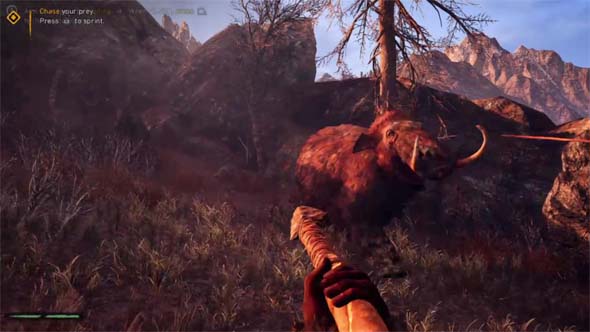
I died in the tutorial because the mammoth charged me before the game taught me how to use my weapon.
It didn't take long, however, for the novelty to wear off. Combat has a focus on melee combat with clubs and spears, which leads to a problem similar to other first-person hack-n-slash games: the constrained field of view makes situational awareness very difficult. Without the option to toggle to a third-person view, it's difficult to tell exactly what is going on immediately around your character, and close-quarters combat with mobs frequently degraded into just spinning around mashing the attack button. Fighting animals can be even worse, as many of them (such as dholes and badgers) are small and fast and incredibly difficult to actually hit. The problem is mitigated somewhat as the game goes on, as new utility abilities are introduced, but I was saddened that Ubisoft didn't really do anything particularly interesting with the basic combat.
And it doesn't really get much better when the utility abilities are introduced, as they mostly just involve simply sicking your tamed beasts on the enemies and hoping that the beast doesn't die. In the regular gameplay mode, you'll also have access to overpowered one-hit kill attacks and bombing runs with your owl that act similarly to an air strike or artillery bombardment in other games. These attacks are so overpowered that the Survival Mode disables them entirely. If you have a powerful enough wolf, bear, or saber-tooth tiger beast, you can often just get away with commanding it to charge a group of enemies while you sit back and watch.
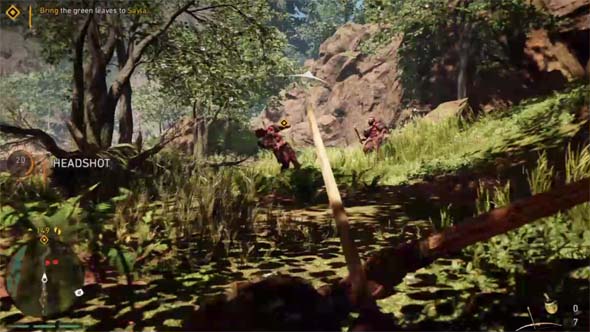
This is one game in which a bow and arrow actually makes sense as a primary weapon. [More]
f789f1b9-8096-44f0-a9aa-91493a4c83b7|0|.0
Tags:Far Cry, Far Cry: Primal, Ubisoft, prehistory, caveman, mammoth, wolf, bear, saber-tooth tiger, owl, beast, beast master, bow and arrow, spear, club, crafting, survival, open world, Darwin Award, Achievement unlocked
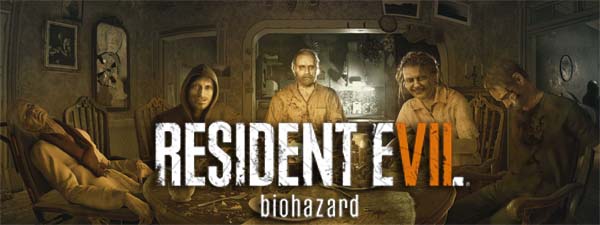
It's been a long time since I've given a crap about Resident Evil. I loved the classic Resident Evil games. The Play Station original is a foundational game for me, and jump-started my interest in horror and the macabre. I felt like the series jumped the shark with Resident Evil 4, however, and my interest in the series tanked with its abandonment of horror in favor of schlockey action-shooter gameplay. I played through Resident Evil 5's co-op with a friend, but didn't really enjoy myself, and after playing the abysmal demo for RE6, I skipped that one entirely.
So I was genuinely excited by Resident Evil VII: Biohazard. The popularity of first-person horror games, and the phenomenon that was P.T. / Silent Hills (not to mention the success of Resident Evil REmastered on Steam) obviously seems to have kicked Capcom in the butt and reminded them that there is still an audience for genuine horror games - an audience that mainstream gaming has neglected for most of the last decade. I'm not sure if development of REVII started as a response to P.T., or if it was already in the works following the success of games like Amnesia, Outlast, and Alien: Isolation. Either way, it's good to see major publishers embracing the genre again.
The family's new - but familiar - mansion
This new Resident Evil really does go back to the franchise's roots. The early hours of the game actually feel a lot like a combination of the original Resident Evil and Resident Evil 3: Nemesis, but updated with a first-person camera and a lot of modern horror contrivances. Long-time fans of the series will recognize the safe rooms and item-boxes. The classic health status indicator is now part of a watch on the character's wrist that you can see whenever you pull up your inventory. There's a foyer with a balcony. Doors are locked by silly, esoteric puzzle mechanisms that require themed keys, crests or various other stand-ins for keys. There's even a booby-trapped shotgun to tease you at the start of the game. Some of these elements of design feel appropriate, while other ham-fisted call-backs admittedly feel like the developers were trying too hard.
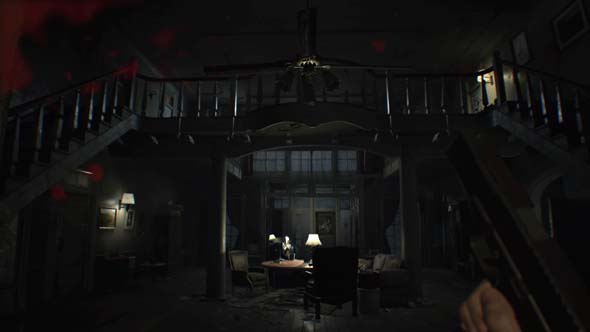
The mansion is new, but has many call-backs to the first game.
The map is well-designed, with its claustrophobic hallways, shortcuts, and lots of visual detail. Lighting is excellent, though the game is a bit too dark at the recommended brightness level (at least without a flashlight), and it becomes washed-out at higher brightness settings. Sound design is also quite exceptional, with the game giving great audio feedback (especially for the pursing stalkers). I also like a lot of the little details, particularly how using a key to unlock a door takes a small amount of time, during which you are vulnerable.
The family also makes for some excellent antagonists, especially compared to the likes of stupid, campy villains like Albert Wesker and Salazar. These villains have a lot of character, and there's enough detail in the mansion to give a sense of who these people might have been before they went off the deep end: the collectible football bobbleheads, for example. And on top of that, they are genuinely disturbing and threatening, and the whole game would probably be scary enough if you just spent the whole time avoiding them and trying to escape their murder house.
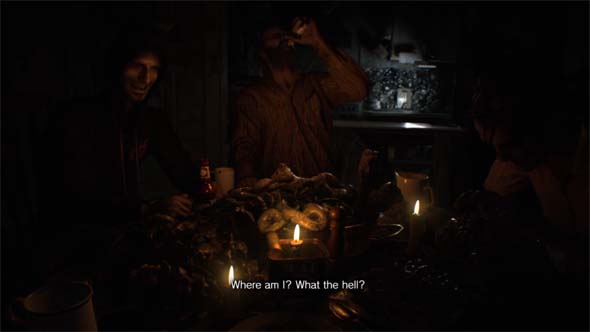
The family makes for genuinely disturbing villains that put RE's earlier villains to shame.
The save system is kind of an odd hybrid of the classic save system and more modern checkpoint systems. The logistics of the classic system have been scaled back, as you no longer require a consumable item (ink ribbon) to manually save (at least not on the default difficulty). But the game will also checkpoint you at certain points, and it maintains a single autosave slot with your checkpointed progress. So if you die to one of the obnoxiously-hard bosses, you don't have to go back a whole hour to your last manual save; instead, you get to restart at the most recent checkpoint.
However, the manual saves still have value, because Biohazard is structurally very similar to the original Resident Evil - both superficially and in terms of gameplay... [More]
a4e07563-fcc1-4e63-88fa-f5d8f517792b|1|5.0
Tags:Resident Evil, Biohazard, Resident Evil 7: Biohazard, Capcom, horror, survival horror, shooter, first person, inventory, resource management, mansion, autosave, save system, puzzle, logistics
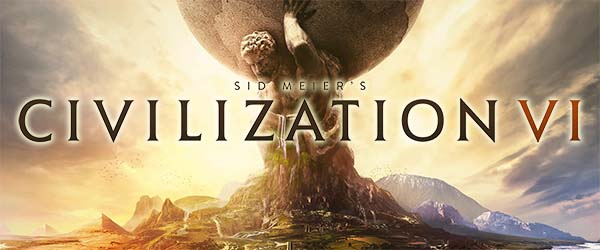
I really like Civilization VI! Of course, it has its share of nagging problems (some of which have been resolved already) - any game of this size and scope is likely to have issues at release. I've already been thinking of some ideas for how the game could be improved in expansions and DLC, and I'd like to spend a few posts to share some of those ideas with you now.
In my review of the game, I mentioned that oceans feel like they've regressed a bit since Beyond Earth: Rising Tide, in that they've returned to feeling like lifeless dead space on the map. Even though they're more important for Holy Sites and Campuses, mountains are also still mostly dead space on the map. They act as obstacles, and that's basically it. In expansions and DLC, I would like to see some of this space become more alive and useful. I'd like to spend this first suggestion post going over some ideas that I have for expanding the ocean mechanics, and for taking advantage of more of the map's dead space.
I have posted a link to this blog on Civfanatics at:
https://forums.civfanatics.com/threads/using-more-of-the-dead-space-in-the-map.610171/.
Feel free to discuss through the comments on this post, or via the linked forum topic!
Improve coastal cities
I'm very underwhelmed with coastal cities right now. Water tiles have very little utility. They provide small yield, can't have districts (other than a single harbor per city), and generally lack production. Coastal cities with lots of water are, thus, very unproductive and not really worth building. I think there's a couple ways to resolve this.
Harbors could provide a small amount of production. Or perhaps Harbors could act similarly to lighthouses from Civ V and provide production on sea resources. Or they could provide production on all adjacent sea tiles (so that placement is still important, and more of those empty sea tiles become useful and worth working, and you actually have to work them in order to get the benefit (as opposed to the Harbor just having an adjacency bonus). If we want to only use adjacency bonuses, then another alternative might be for Harbors to provide +1 production per adjacent coastal resource and +0.5 gold per adjacent water tile. That way, even cities that don't have clustered water resources can still have valuable locations for harbors.
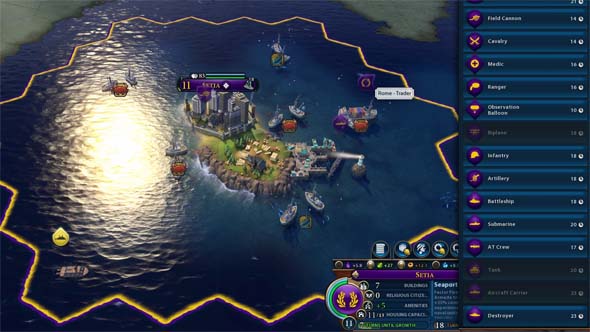
Coastal and island cities lack production and have limited space to build districts.
Another way to improve coastal cities would be to have some more early policies that benefit coastal cities. Perhaps the Maritime Industries policy could be changed to "+1 production in coastal cities, and +1 production from Harbors". Alternatively, Maritime Industries could be similar to the Veterancy policy, and it could provide "+33% production towards Harbor districts and buildings for that district". Or we could have policies that do both! A new policy could be added that provides the bonus production for early naval units. Maybe there can even be a whole extra early-game civic (maybe called "Seafaring" or "Way-finding") that has some policies and buffs towards coastal and island civilizations.
The lack of production for coastal cities could also be offset by giving them more gold and/or food for growth (in order to support a specialist economy)... [More]
0a6b7d05-286b-42c2-b6f9-dbbeca807f1a|1|5.0
Tags:Sid Meier's Civilization, Civilization VI, civilization, strategy, map, ocean, coast, beach, boardwalk, fishery, wind farm, island, mountain, observatory, astronomy, ski resort, tourism, tunnel, canal, navy, cities, Polynesia, way-finding, national park, naturalist, Civilization: Beyond Earth: Rising Tide
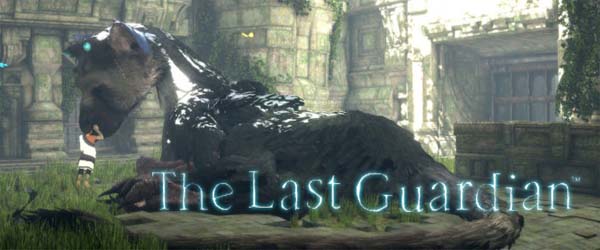
Being the follow-up to a masterpiece is no small order. Being the follow-up to two masterpieces is a Sisyphean task. Ico is a masterpiece of its time. Fumito Ueda and SIE Japan managed to follow that game with Shadow of the Colossus - a masterpiece of even higher order. The bar was set tremendously high for the team's third project: The Last Guardian. Multiple delays, a change in platform from PS3 to PS4, and Fumito Ueda's departure from Sony squashed a lot of the hype for the game. Might the game turn into vaporware? Or might it release in a condition analogous to Metal Gear Solid V?
On the surface, The Last Guardian comes off as being a mash-up of Ico and Shadow of the Colossus. Superficially, it's much more in-line with Ico: you play as a small boy who must guide a companion through a maze of environmental platformer obstacles and adventure puzzles. The catch this time around is that the companion happens to be a giant animal that you can climb and ride on.
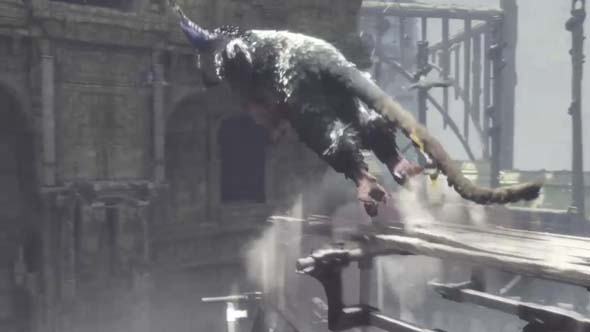
The Last Guardian share more with Ico, but your companion is a giant creature that you climb and ride on.
The big difference though, is that The Last Guardian is sort of an inversion of the gameplay of Ico. In Ico, the player character had to guide a helpless (some even speculated she is blind) princess through a castle and defend her from shadow monsters that try to drag her away. In The Last Guardian, however, it is the player character - the boy - who is mostly helpless. True, you have most of the agency and are guiding Trico through the maze. But Trico is the one with all the power, and your progress is often dependent on Trico getting you past obstacles.
This point is most hammered home by the game's combat mechanics - or rather, its almost complete lack thereof. The boy can't fight off the stone knights that hunt him down. You can only run away, or let Trico smash them into dust for you. If they catch you, they drag you off to a nearby mysterious blue doorway (a parallel to the smokey portals that the smoke monsters dragged Yorda through in Ico), and all you can do is mash buttons to kick and squirm. Ico and Shadow of the Colossus experimented with player agency by making the player question the motivations of the character and wonder if maybe you're doing more harm than good. The Last Guardian toys with agency in other ways. In this game, you, the player, are the helpless tag-along character in an escort quest. You get a glimpse through the eyes of Yorda from Ico or Ashley from Resident Evil 4.
The boy can't fight back, he can only kick and squirm - much like Yorda from Ico.
Not entirely though. The player and Trico make mutual contributions to progress, and their contributions are shared much more than Ico and Yorda. Much like how Yorda could occasionally open the magically-locked doors, the boy in Guardian also has to pull levers and open doors for Trico to pass from room to room. The boy also has to destroy glass eye murals that mesmerize and terrify Trico to the point of paralysis. The boy also hunts down barrels of [supposedly] food for Trico to eat whenever Trico is tired or wounded. But then there's also parts of the game in which the boy simply hops on Trico's back, and Trico leaps away to the next puzzle area without the player having to do anything... [More]
54c716c5-4407-4898-bee0-0725c5a7ce3e|1|5.0
Tags:The Last Guardian, Team Ico, Fumito Ueda, puzzle, platformer, Trico, child, escort quest, Ico, Shadow of the Colossus, PlayStation 4, Sony, exclusive, vaporware, Achievement unlocked

Earlier this month, I posted a suggestion for hiding player ratings until the player has played enough games to reveal them. Afterwards, I posted a list of my suggestions for offense, defense, and special teams for Madden 18. That still leaves some other outstanding areas of improvement such as Franchise mode, and I'd like to spend this post focusing there.
Let's start out by going over some of the things that are left over from last year's wishlist:
A lot of these items are related to Franchise, and so keep them in mind as you read through this post. But before I jump into franchise suggestions, let's first look at the issue of the Accelerated clock as it has been implemented in Madden for years:
Accelerated clock, two-minute drill, and CPU timeouts
I've brought this up before, but clock management really needs to be addressed. The accelerated clock should never be disabled! Not in the two-minute drill; not ever. The two minute drill is when it is most important to enforce the accelerated clock because otherwise it completely breaks the two-minute drill. The CPU is particularly bad at exploiting this. I regularly see the CPU go into a huddle and break it within 5 seconds of game clock, which is faster than if they had tried a hurry-up, and which spares them from using a timeout. Human users can exploit this same tactic as well in order to avoid the time it takes to run up to the line. All you have to do is quickly select any pass play then audible or hot route your receivers.
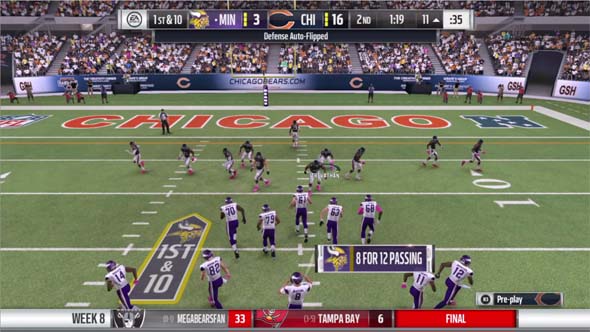
Breaking a 2-minute drill huddle with 35 seconds on the play clock while
the game clock is running completely breaks the 2-minute drill.
And speaking of CPU timeouts: the CPU should actually use them. There should be some logic in place where if a CPU QB either can't figure out the pre-snap coverage, or he doesn't like the pre-snap coverage, then he should call a timeout to mulligan the play. This should happen if the defense puts eight men in the box when an inside run was called, or if the CPU QB reads press coverage on a wide receiver screen, or other such situations in which the the CPU determines that the player's play is likely to trump their play call. This should be tied to a QB's Awareness and/or Play Recognition rating, and there could maybe also be a small chance that if the QB doesn't make the right read, then the coach can call a timeout instead. CPU defenses should similarly be able to burn a timeout if they read a particularly unfavorable personnel match-up.
Another improvement that could be made to the accelerated clock is to add some variability to it... [More]
653828a4-3a4f-4812-8eb5-5ec438b1eac3|0|.0
Tags:Madden NFL, Madden NFL 17, Madden NFL 18, accelerated clock, two-minute drill, timeout, franchise, tie, injury, concussion, goal, roster, draft, draft board, draft class, college, NCAA Football, tuning, Patrick Willis, Arian Foster, Joe Montana, Brett Favre, NBA 2k16
|

| 12 | | | | | | | 60 | | 11 | | | | | | | 55 | | 10 | | | | | | | 50 | | 09 | | | | | | | 45 | | 08 | | | | | | | 40 | | 07 | | | | | | | 35 | | 06 | | | | | | | 30 | | 05 | | | | | | | 25 | | 04 | | | | | | | 20 | | 03 | | | | | | | 15 | | 02 | | | | | | | 10 | | 01 | | | | | | | 05 |
|